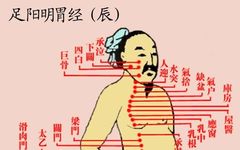The Shí’èr jīngmài (Twelve Meridians) are the main content of the meridian theory.“The Twelve Meridians are internally connected to the fǔzàng (organs) and externally linked to the limbs and joints,” which summarizes the distribution characteristics of the Twelve Meridians:Internally, they are affiliated with the zàngfǔ (organs);Externally, they are distributed throughout the body.Moreover, because the meridians are responsible for the “flow of blood and qi,” their pathways have a specific direction;this is referred to as the “direction of the pulse flow,” later termed “liúzhù” (flow and distribution);the various meridians are also interconnected through branches, which is referred to as “the correspondence between internal and external, all having surface and interior connections.”
Fù yángmíng wèi jīng (Stomach Meridian of the Foot Yangming)
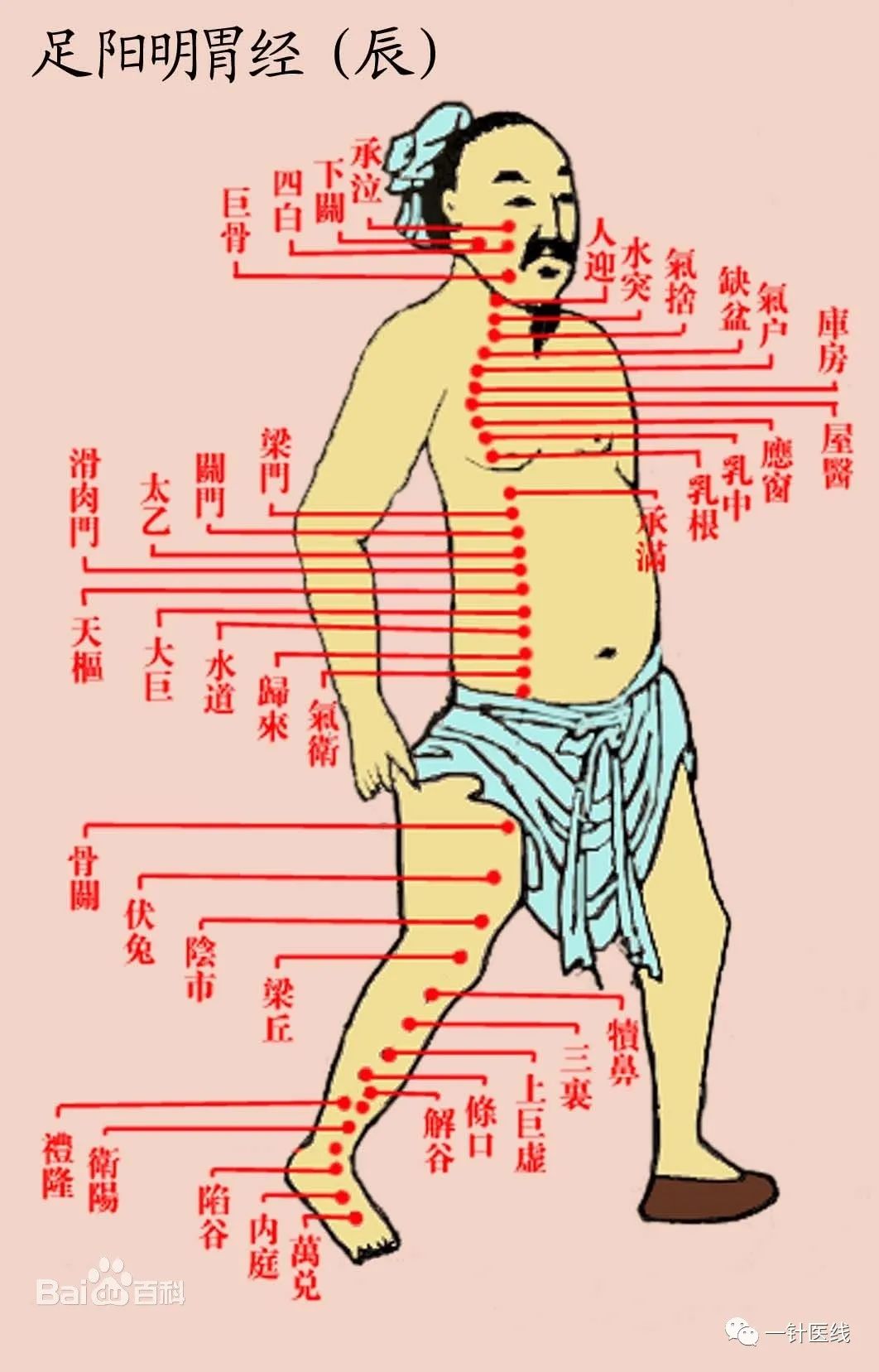

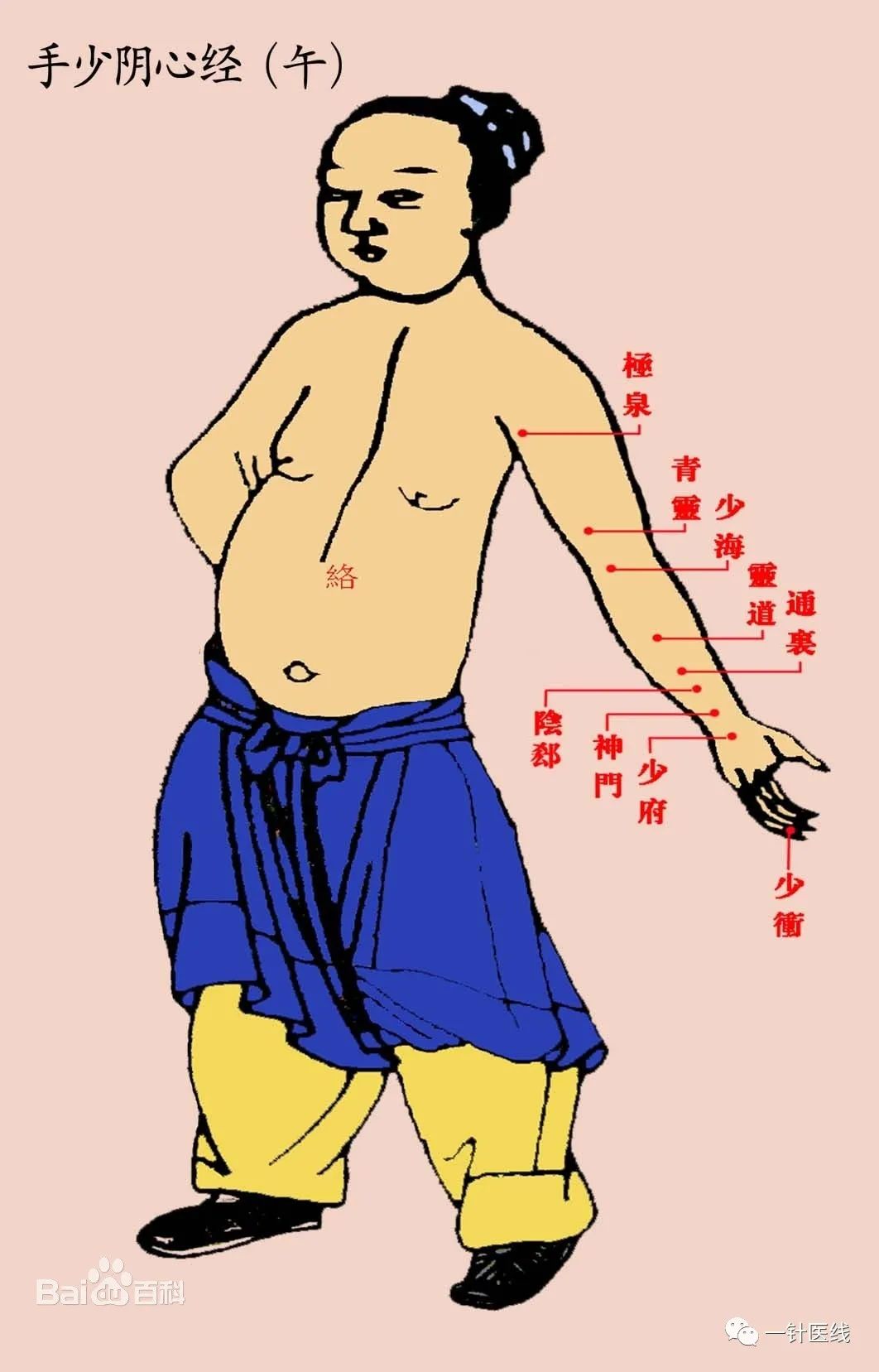
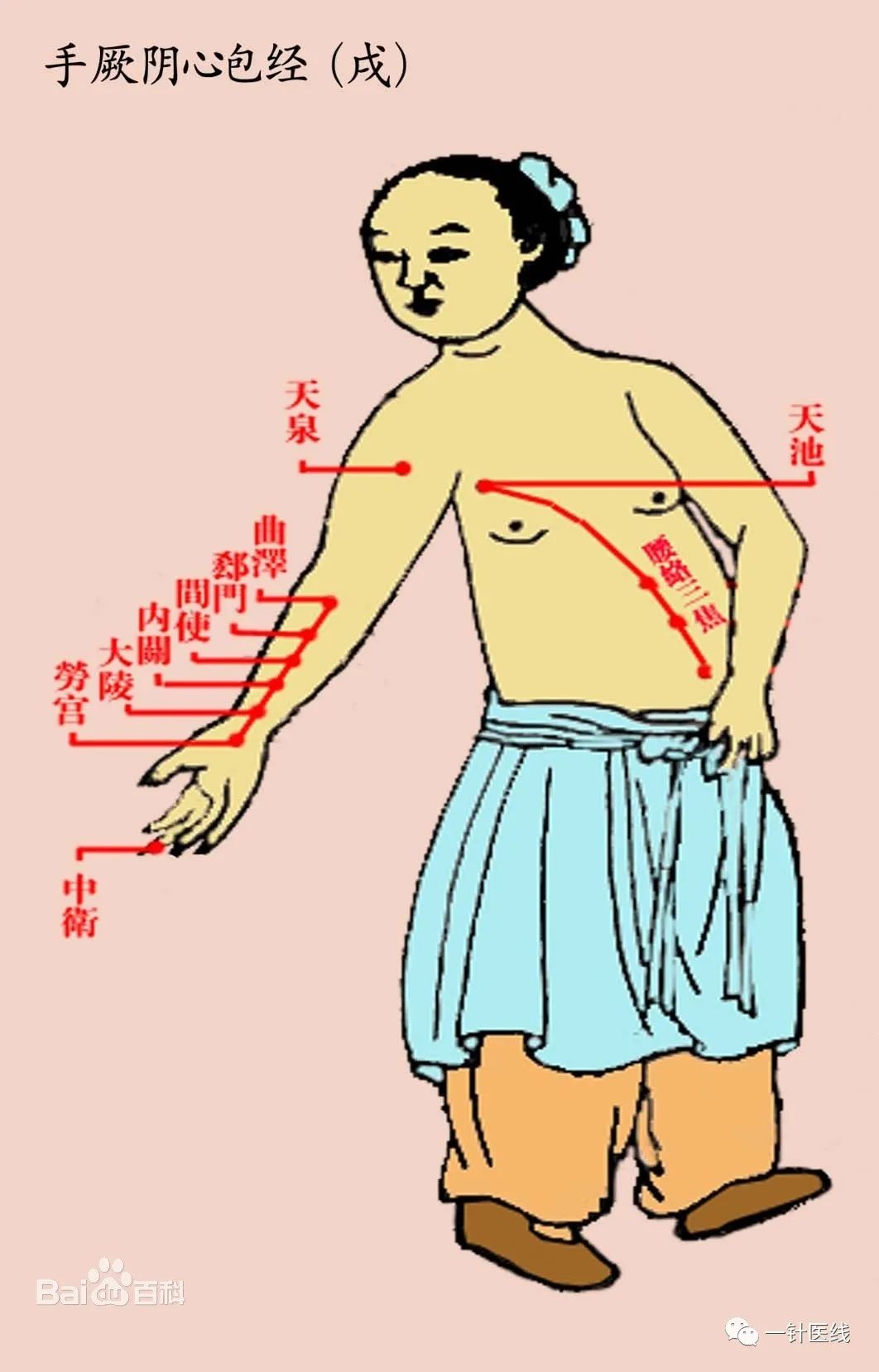
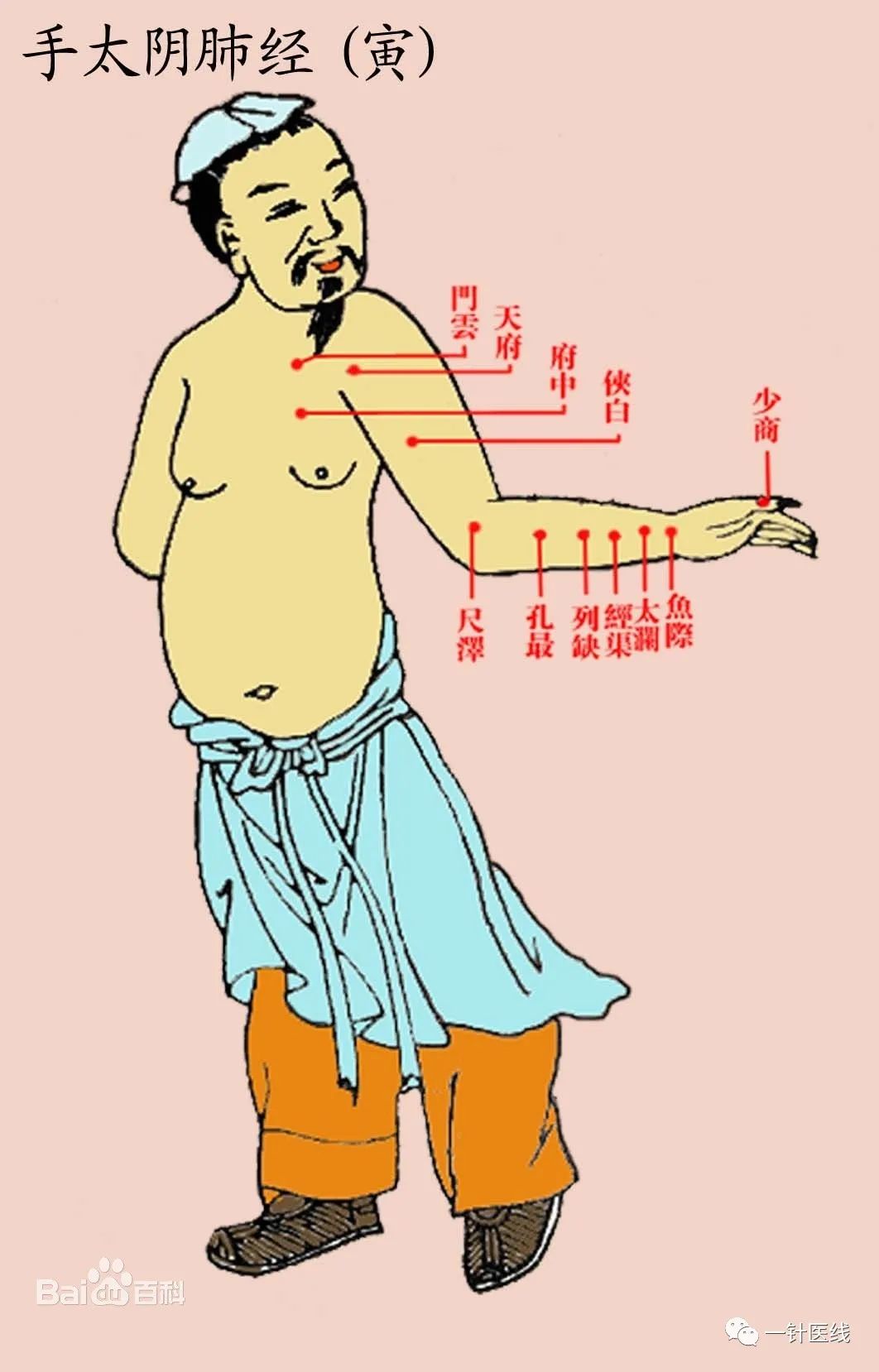
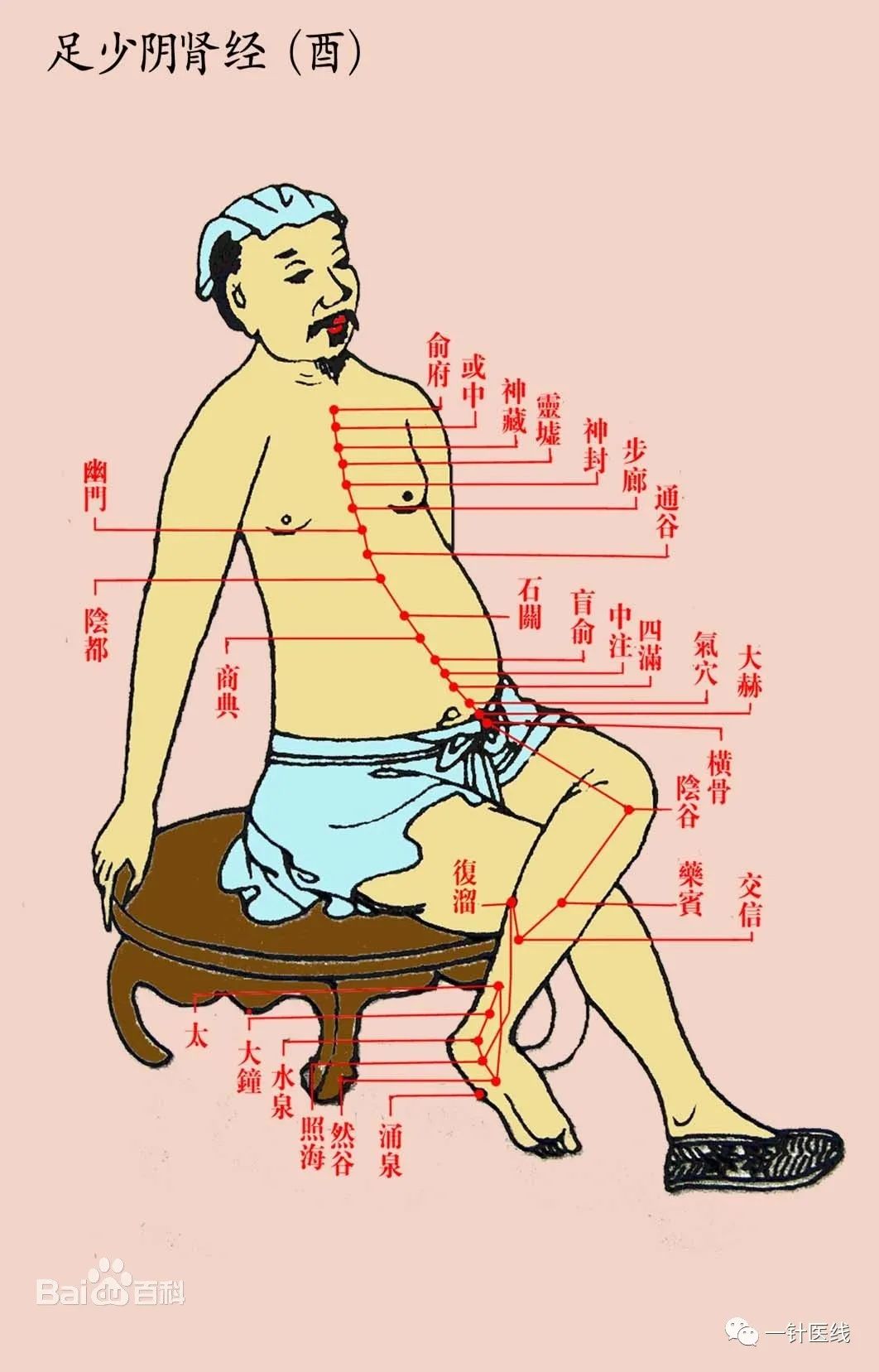
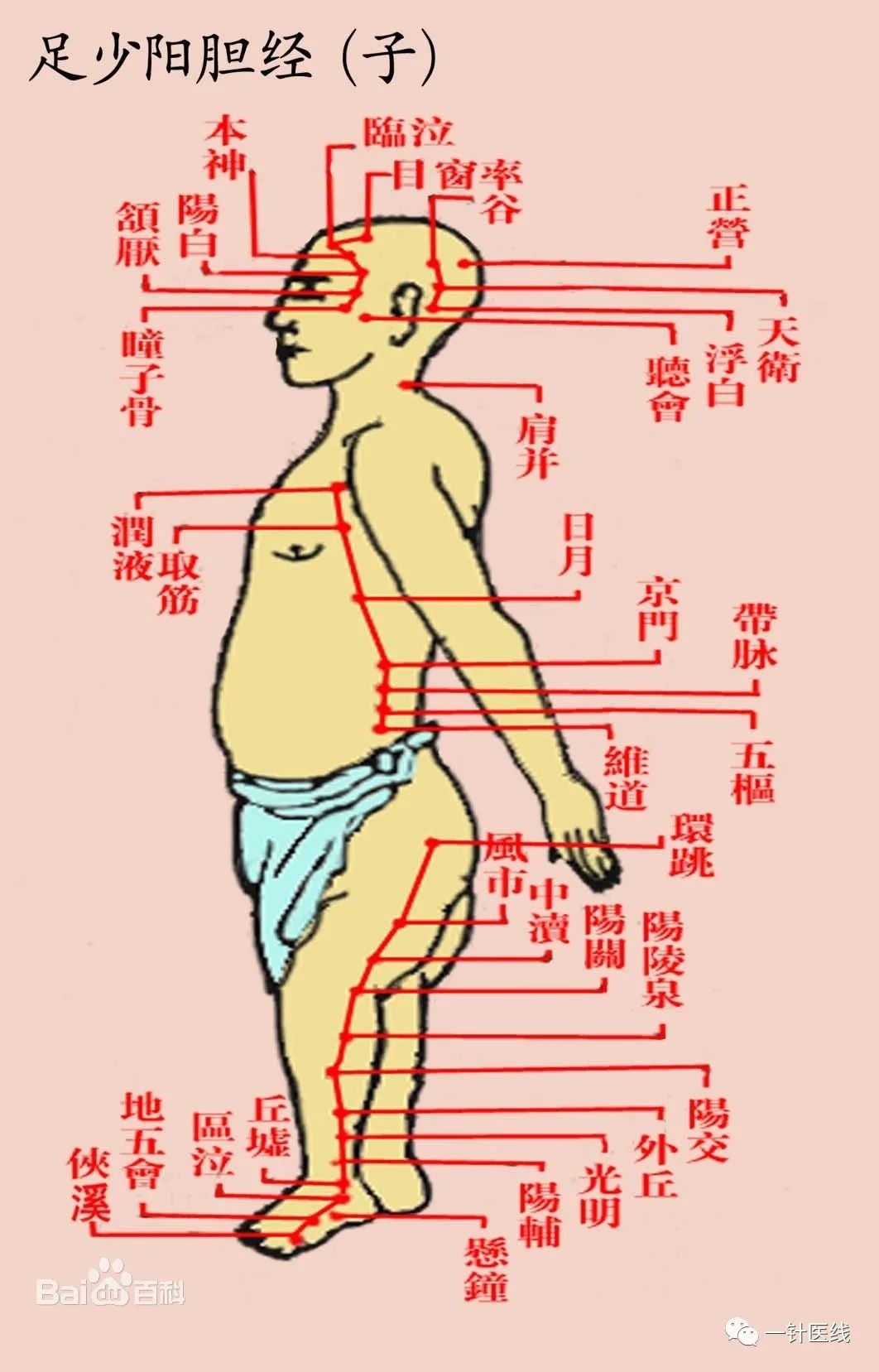
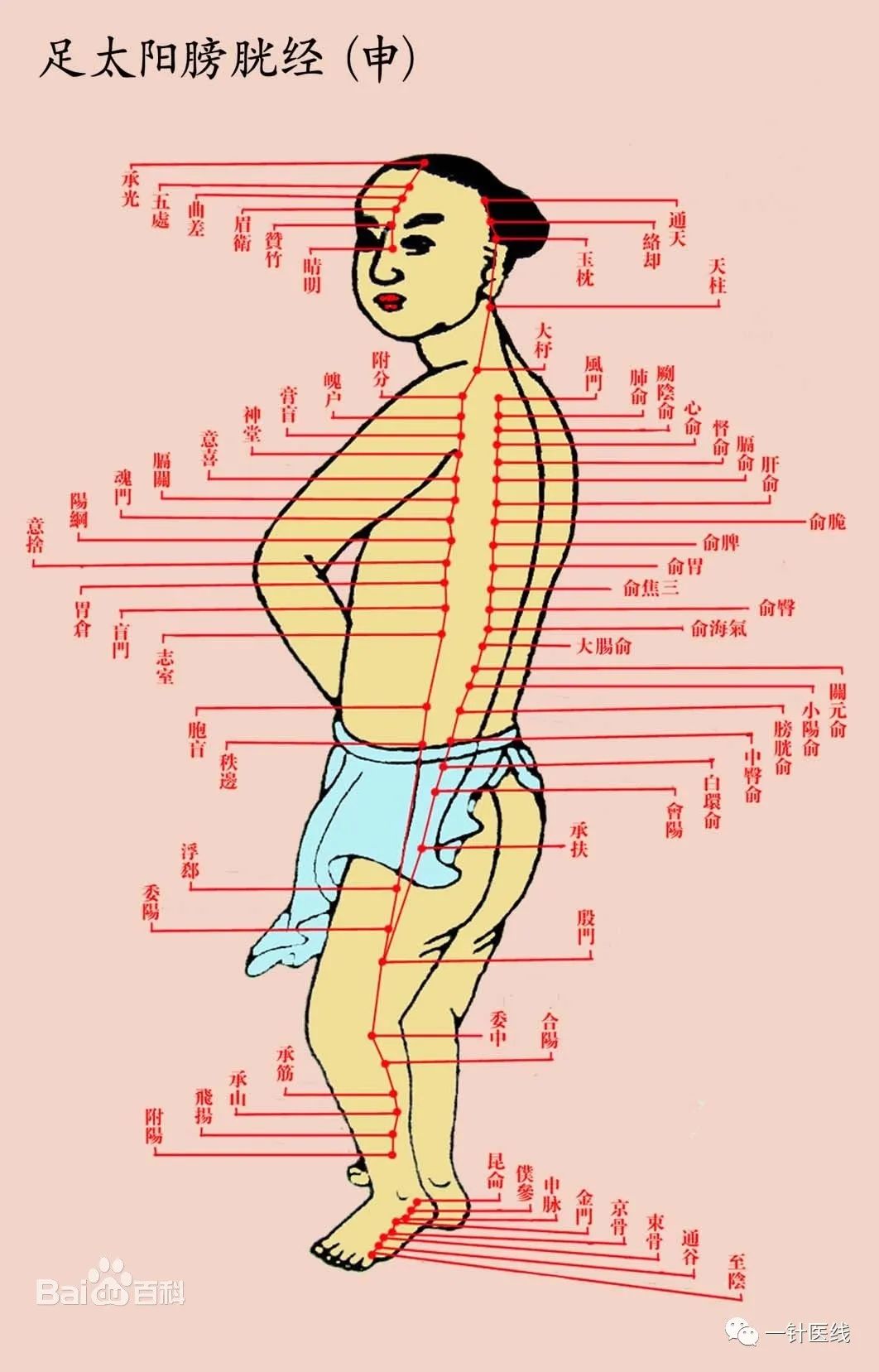
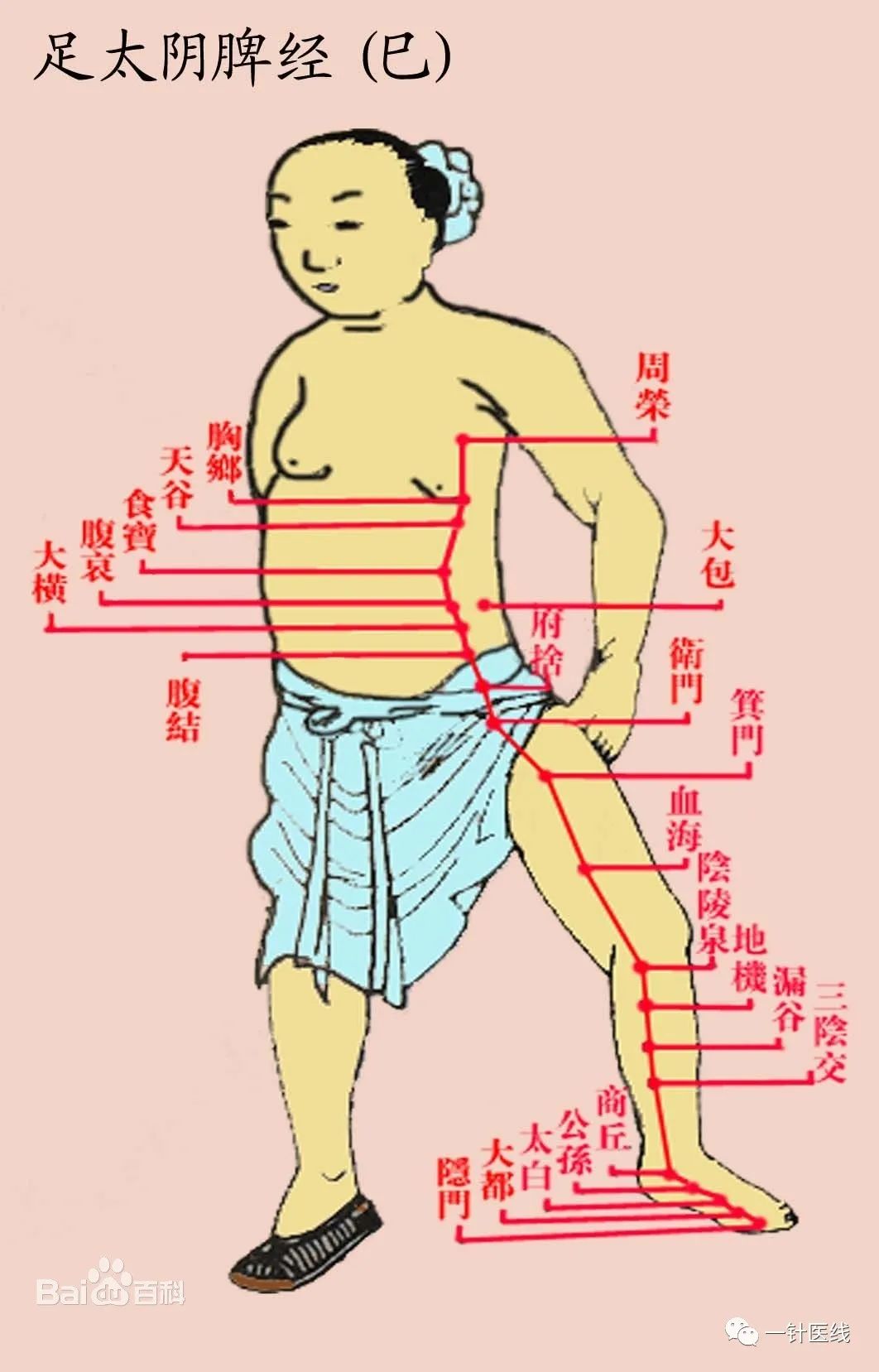
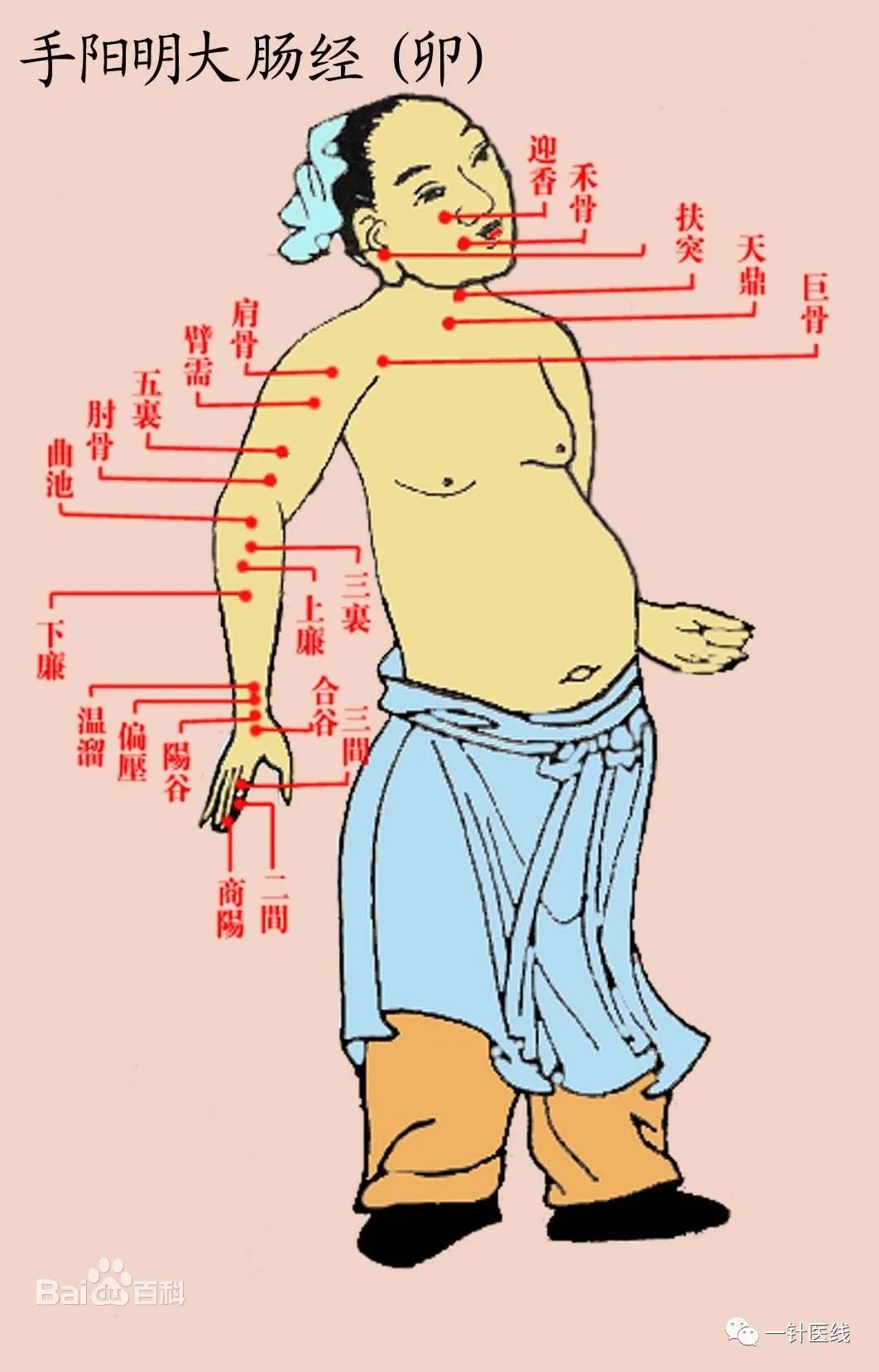
Shǒu tàiyīn fèijīng (Lung Meridian of the Hand Taiyin)
Shǒu tàiyīn fèijīng is primarily distributed along the inner front edge of the upper limb, its connecting vessels and branches link internally and externally, and the sinews are distributed externally.
Shǒu yángmíng dàchángjīng (Large Intestine Meridian of the Hand Yangming)
Shǒu yángmíng dàchángjīng is mainly distributed along the outer front edge of the upper limb, its connecting vessels and branches link internally and externally, and the sinews are distributed externally.
Fù yángmíng wèi jīng (Stomach Meridian of the Foot Yangming)
Fù yángmíng wèi jīng is primarily distributed in the head, face, chest, abdomen along the second lateral line, and the outer front edge of the lower limb, its connecting vessels and branches link internally and externally, and the sinews are distributed externally.
Fù tàiyīn pǐjīng (Spleen Meridian of the Foot Taiyin)
Fù tàiyīn pǐjīng is primarily distributed along the second lateral line beside the Ren Meridian in the chest and abdomen, and the inner front edge of the lower limb, its connecting vessels and branches link internally and externally, and the sinews are distributed externally.
Shǒu shǎoyīn xīnjīng (Heart Meridian of the Hand Shaoyin)
Shǒu shǎoyīn xīnjīng is primarily distributed along the inner back edge of the upper limb, its connecting vessels and branches link internally and externally, and the sinews are distributed externally.
Shǒu tàiyáng xiǎochángjīng (Small Intestine Meridian of the Hand Taiyang)
Shǒu tàiyáng xiǎochángjīng is primarily distributed along the outer back edge of the upper limb, its connecting vessels and branches link internally and externally, and the sinews are distributed externally.
Fù tàiyáng pángguāngjīng (Bladder Meridian of the Foot Taiyang)
Fù tàiyáng pángguāngjīng is primarily distributed along the first and second lateral lines of the lower back and the outer back edge of the lower limb, its connecting vessels and branches link internally and externally, and the sinews are distributed externally.
Fù shǎoyīn shènjīng (Kidney Meridian of the Foot Shaoyin)
Fù shǎoyīn shènjīng is primarily distributed along the inner back edge of the lower limb and the first lateral line of the chest and abdomen, its connecting vessels and branches link internally and externally, and the sinews are distributed externally.
Shǒu juéyīn xīnbāojīng (Pericardium Meridian of the Hand Jueyin)
Shǒu juéyīn xīnbāojīng is primarily distributed along the middle inner side of the upper limb, its connecting vessels and branches link internally and externally, and the sinews are distributed externally.
Shǒu shǎoyáng sānjiāojīng (Triple Burner Meridian of the Hand Shaoyang)
Shǒu shǎoyáng sānjiāojīng is primarily distributed along the middle outer side of the upper limb, its connecting vessels and branches link internally and externally, and the sinews are distributed externally.
Fù shǎoyáng dǎnjiāojīng (Gallbladder Meridian of the Foot Shaoyang)
Fù shǎoyáng dǎnjiāojīng is primarily distributed along the middle outer side of the lower limb, its connecting vessels and branches link internally and externally, and the sinews are distributed externally.
Fù juéyīn gān jīng (Liver Meridian of the Foot Jueyin)
Fù juéyīn gān jīng is primarily distributed along the middle inner side of the lower limb, its connecting vessels and branches link internally and externally, and the sinews are distributed externally.
Shí’èr jīngbié (Twelve Divergent Meridians)
The divergent meridians are the branches of the main meridians. The pathways of the Twelve Divergent Meridians all originate from the limb portions of the Twelve Meridians (mostly above the elbow and knee) and diverge (referred to as “lí”), entering the internal organs (referred to as “rù”), then superficially emerging (referred to as “chū”) to the head and face, where the divergent meridians of the yin channels merge into those of the yang channels and separately enter the six yang meridians (referred to as “hé”). Therefore, the characteristics of the pathways of the Twelve Divergent Meridians can be summarized as “lí, hé, chū, rù.” Each pair of corresponding divergent meridians forms a “hé,” and the Twelve Divergent Meridians collectively form the “liùhé” (six harmonies). The main function of the Twelve Divergent Meridians is to strengthen and coordinate the connections between the meridians, between the meridians and the organs, as well as among various organs and tissues of the body.
Fù tàiyáng yǔ fù shǎoyīn
(Yī hé)
1.Fù tàiyáng jīngbié: originates from the popliteal region of the Fù tàiyáng jīng, with one branch entering the anus five cun below the sacrum, ascending to the bladder, dispersing to connect with the kidneys, and along the muscles beside the spine to the heart, dispersing within the heart; a straight branch continues upward from the muscles beside the spine, superficially emerging at the nape, with the pulse qi still entering the Fù tàiyáng main channel.
2.Shǎoyīn jīngbié: originates from the popliteal region of the Fù shǎoyīn jīng, merging and running alongside the Fù tàiyáng jīngbié, ascending to the kidneys, diverging at the fourteenth vertebra (second lumbar), belonging to the belt vessel; a straight branch continues upward, connecting at the root of the tongue, then superficially emerging at the nape, with the pulse qi entering the Fù tàiyáng jīngbié.
Fù shǎoyáng yǔ fù juéyīn
(Èr hé)
3.Fù shǎoyáng jīngbié: originates from the Fù shǎoyáng jīng at the outer thigh, wrapping around the front of the thigh, entering the hairline, merging with the Fù juéyīn jīngbié, ascending between the ribs, along the thoracic cavity, belonging to the gallbladder, dispersing upward to the liver, passing through the heart, ascending along the esophagus, superficially emerging at the jaw and mouth, dispersing on the face, connecting at the outer canthus of the eyes, with the pulse qi still entering the Fù shǎoyáng jīng.
4.Fù juéyīn jīngbié: originates from the dorsum of the foot, ascending to the hairline, merging and running alongside the Fù shǎoyáng jīngbié.
Fù yángmíng yǔ fù tàiyīn
(Sān hé)
5.Fù yángmíng jīngbié: originates from the front of the thigh, entering the abdominal cavity, belonging to the stomach, dispersing to the spleen, ascending through the heart, along the esophagus, superficially emerging in the mouth, reaching the root of the nose and the lower eye socket, returning to connect with the eye system, with the pulse qi still entering the Fù yángmíng main channel.
6.Fù tàiyīn jīngbié: originates from the inner side of the thigh, moving to the front of the thigh, merging and running alongside the Fù yángmíng jīngbié, connecting at the throat, penetrating the tongue.
Shǒu tàiyáng yǔ shǒu shǎoyīn
(Sì hé)
7.Shǒu tàiyáng jīngbié: originates from the shoulder joint of the Shǒu tàiyáng jīng, descending into the armpit, moving toward the heart, connecting with the small intestine.
8.Shǒu shǎoyīn jīngbié: originates from between the two tendons in the armpit, entering the thoracic cavity, belonging to the heart, ascending to the throat, superficially emerging on the face, merging with the Shǒu tàiyáng jīng at the inner canthus of the eyes.
Shǒu shǎoyáng yǔ shǒu juéyīn
(Wǔ hé)
9.Shǒu shǎoyáng jīngbié: originates from the top of the head of the Shǒu shǎoyáng jīng, descending into the supraclavicular fossa. Passing through the upper, middle, and lower burners, dispersing in the chest.
10.Shǒu juéyīn jīngbié: originates from three cun below the armpit, entering the thoracic cavity, belonging to the upper, middle, and lower burners, ascending along the throat, superficially emerging behind the ear, merging with the Shǒu shǎoyáng jīng below the mastoid process.
Shǒu yángmíng yǔ shǒu tàiyīn
(Liù hé)
11.Shǒu yángmíng jīngbié: originates from the shoulder point of the Shǒu yángmíng jīng, entering the back of the neck, descending toward the large intestine, belonging to the lung; ascending, along the throat, superficially emerging at the supraclavicular fossa. The pulse qi still belongs to the Shǒu yángmíng main channel.
12.Shǒu tàiyīn jīngbié: originates from the yuān yè point, running before the Shǒu shǎoyīn jīngbié, entering the thoracic cavity, moving toward the lungs, dispersing in the large intestine, ascending, superficially emerging at the supraclavicular fossa, merging with the Shǒu yángmíng jīngbié.
Shíwǔ luò mài (Fifteen Connecting Vessels)
⑴ Shǒu tàiyīn zhī bié luò: originates from the Lièxuè point, starting above the wrist joint, running toward the Shǒu yángmíng jīng at half an inch behind the wrist; its branch runs alongside the Shǒu tàiyīn jīng, directly entering the palm, dispersing in the fish border area.
⑵ Shǒu yángmíng zhī bié luò: originates from the Piānlì point, running toward the Shǒu tàiyīn jīng three inches behind the wrist; its branch ascends along the arm, passing through the shoulder, ascending to the angle of the jaw, dispersing in the teeth, with its branch entering the ear, merging with the zōng mài.
⑶ Fù yángmíng zhī bié luò: originates from the Fēnglóng point, running eight inches above the outer ankle, toward the Fù tàiyīn jīng; its branch runs along the outer edge of the tibia, connecting upward to the head and neck, merging with the pulse qi of each channel, and connecting downward to the throat.
⑷ Fù tàiyīn zhī bié luò: originates from the Gōngsūn point, running one inch behind the first toe joint, toward the Fù yángmíng jīng; its branch enters the abdominal cavity, connecting with the intestines and stomach.
⑸ Shǒu shǎoyīn zhī bié luò: originates from the Tōnglǐ point, running one inch behind the wrist toward the Shǒu tàiyáng jīng; its branch diverges one and a half inches behind the wrist, ascending along the main channel into the heart, connecting upward to the root of the tongue, linking to the eye system.
⑹ Shǒu tàiyáng zhī bié luò: originates from the Zhīzhèng point, running five inches behind the wrist, injecting into the Shǒu shǎoyīn jīng; its branch ascends through the elbow, networking at the shoulder.
⑺ Fù tàiyáng zhī bié luò: originates from the Fēiyáng point, running seven inches above the outer ankle, toward the Fù shǎoyīn jīng.
⑻ Fù shǎoyīn zhī bié luò: originates from the Dàzhōng point, wrapping around the heel from behind the inner ankle, running toward the Fù tàiyang jīng; its branch merges with the main channel, ascending to the pericardium, and externally connecting through the lumbar spine.
⑼ Shǒu juéyīn zhī bié luò: originates from the Nèi guān point, emerging two inches behind the wrist between the two tendons, ascending along the main channel, connecting with the pericardium, and networking with the heart.
⑽ Shǒu shǎoyáng zhī bié luò: originates from the Wàiguān point, emerging two inches behind the wrist, wrapping around the outer side of the arm, entering the chest, merging with the Shǒu juéyīn jīng.
⑾ Fù shǎoyáng zhī bié luò: originates from the Guāngmíng point, running five inches above the inner ankle, toward the Fù juéyīn jīng, connecting downward to the dorsum of the foot.
⑿ Fù juéyīn zhī bié luò: originates from the Lìgōu point, running five inches above the inner ankle, toward the Fù shǎoyáng jīng; its branch ascends along the tibia, reaching the testicular area, converging at the penis.
⒀ Rèn mài zhī bié luò: originates from the Jiūwěi point (Tails of the Tail), descending from the sternum, dispersing in the abdomen.
⒁ Dū mài zhī bié luò: originates from the Chángqiáng point, ascending along both sides of the spine to the nape, dispersing on the head; the descending connecting vessels start from the shoulder blade, diverging along the Fù tàiyáng jīng, entering the muscles beside the spine.
⒂ Pǐ zhī dà luò: originates from the Dàbāo point, emerging three inches below the Yuān yè point, dispersing in the chest and ribs.
Qí jīng bā mài (Eight Extraordinary Vessels)
The Eight Extraordinary Vessels refer to the Dū mài, Rèn mài, Chōng mài, Dài mài, Yīn wěi mài, Yáng wěi mài, Yīn qiāo mài, and Yáng qiāo mài. Unlike the twelve primary meridians, they do not directly belong to the organs and do not have a surface-interior relationship, “bì dào qí xíng,” hence they are called “extraordinary vessels.” The Dū, Rèn, and Chōng vessels all originate from the womb, emerging from the perineum, referred to as “one source with three divergences,” where the Dū mài runs along the midline of the back, ascending to the head and face; the Rèn mài runs along the midline of the chest and abdomen, reaching the chin; the Chōng mài ascends alongside the Fù shǎoyīn kidney meridian, encircling the lips. The Dài mài originates from the sides of the ribs, encircling the waist. The Yīn wěi mài originates from the inner side of the calf, ascending along the inner side of the leg, reaching the throat and merging with the Rèn mài. The Yáng wěi mài originates from the outer side of the foot, ascending along the outer side of the leg, reaching the nape and merging with the Dū mài. The Yīn qiāo mài originates from the inner side of the heel, ascending alongside the Fù shǎoyīn and other meridians, reaching the inner canthus of the eyes and merging with the Yáng qiāo mài. The Yáng qiāo mài originates from the outer side of the heel, ascending alongside the Fù tàiyáng and other meridians, reaching the inner canthus of the eyes and merging with the Yīn qiāo mài, ascending along the Fù tàiyáng meridian to the nape, merging with the Fù shǎoyáng meridian.
The Eight Extraordinary Vessels crisscross and distribute between the twelve meridians, primarily serving two functions. First, they connect the twelve meridians. The Eight Extraordinary Vessels link meridians that are close in location and similar in function, achieving the effect of regulating the qi and blood of related meridians and coordinating yin and yang. The Dū mài connects with the six yang meridians, known as the “sea of yang vessels,” regulating the qi of all yang meridians; the Rèn mài connects with the six yin meridians, known as the “sea of yin vessels,” regulating the qi of all yin meridians; the Chōng mài connects with the Rèn and Dū meridians, as well as the Fù yángmíng and Fù shǎoyīn meridians, hence called the “sea of twelve meridians” or “sea of blood,” which has the function of containing the qi and blood of the twelve meridians; the Dài mài restrains and connects the various foot meridians running vertically along the body; the Yīn and Yáng wěi mài connect the yin and yang meridians, respectively governing the exterior and interior of the body; the Yīn and Yáng qiāo mài govern the movement of the lower limbs and the states of wakefulness and sleep. Second, the Eight Extraordinary Vessels regulate the accumulation and infiltration of qi and blood in the twelve meridians. When the qi and blood of the twelve meridians and organs are abundant, the Eight Extraordinary Vessels can accumulate; when the body’s functional activities require it, the Eight Extraordinary Vessels can also infiltrate and supply.
The Chōng, Dài, qiāo, and wěi vessels all attach to the twelve meridians and the Rèn and Dū meridians, but the Rèn and Dū vessels each have their own associated acupoints, thus they are compared with the twelve meridians, collectively referred to as the “fourteen meridians.” The fourteen meridians have specific pathways, symptoms, and associated acupoints, forming the main part of the meridian system, which serves as the basis for acupuncture treatment and the application of medicinal herbs in clinical practice.
1. Dū mài: Dū means to supervise. The Dū mài runs along the midline of the back, supervising all the yang meridians of the body, hence also called the “sea of yang vessels.”
[Pathway] Originates from the womb, descending through the perineum, running along the midline of the back, entering the brain, belonging to the brain, and running along the midline of the head, through the top of the head, forehead, nose, upper lip, to the frenulum of the upper lip. It also connects with the kidney through the earth meridian and penetrates the heart.
Main symptoms: spinal stiffness, arching of the back, back pain, mental disorders, childhood convulsions, etc.
2. Rèn mài: Rèn means to undertake. The Rèn mài runs along the midline of the chest and abdomen, supervising all the yin meridians of the body, hence known as the “sea of yin vessels.”
[Pathway] Originates from the womb, descending through the perineum, running along the midline of the abdomen, through the chest, neck, reaching the inner side of the lower lip, encircling the lips, ascending to the gums, diverging to the two eyes below.
Main symptoms: hernia, leukorrhea, lower abdominal masses, irregular menstruation, miscarriage, infertility, etc.
3. Chōng mài: the key vessel governing the qi and blood of all meridians.
[Pathway] Originates from the womb, dividing into three branches: one branch runs along the posterior wall of the abdominal cavity, ascending within the spine; another branch runs along the anterior wall of the abdominal cavity, alongside the navel, dispersing in the chest, then ascending through the throat, encircling the lips; the third branch descends through the perineum, running along the inner side of the thigh down to the big toe.
Main symptoms: irregular menstruation, amenorrhea, excessive bleeding, insufficient lactation, vomiting blood, and qi counterflow.
4. Dài mài: the Dài mài encircles the waist like a belt, able to restrain all the meridians, hence the saying “all meridians belong to the Dài.”
[Pathway] Originates from the lateral ribs, descending diagonally to the Dài mài point, encircling the waist.
5. Yīn qiāo mài and Yáng qiāo mài: Qiāo means to be agile and quick. Their physiological functions are: Yáng qiāo governs the yang of the body, while Yīn qiāo governs the yin of the body. They also nourish the eyes, controlling the opening and closing of the eyelids and the movement of the lower limbs.
[Pathway] The qiāo vessels are paired on the left and right. Both Yīn and Yáng qiāo vessels originate from the foot.
Main symptoms: Yīn qiāo disorders lead to relaxation of the outer side muscles and tension of the inner side muscles, throat pain, and drowsiness; Yáng qiāo disorders lead to relaxation of the inner side muscles and tension of the outer side muscles, mania, insomnia, and pain in the inner canthus of the eyes.
6. Yīn wěi mài and Yáng wěi mài: Wěi means to connect. The Yīn wěi mài connects the three yin meridians, while the Yáng wěi mài connects the three yang meridians.
[Pathway] The Yīn wěi mài originates from the inner side of the calf, where the three yin meridians intersect, ascending along the inner side of the leg, reaching the abdomen, running alongside the Fù tàiyīn pǐjīng, reaching the lateral ribs, merging with the Fù juéyīn gān jīng, then ascending to the throat, merging with the Rèn mài.
Main symptoms: when the Yīn wěi mài is affected, it often leads to chest pain, heart pain, stomach pain, etc.
Shí’èr jīngjīn (Twelve Muscle Meridians)
Specific distributions are as follows:
1.Fù tàiyáng jīngjīn: originates from the little toe, ascending to the outer ankle, diagonally ascending to the knee, while the lower part connects to the outer ankle at the heel, ascending along the Achilles tendon to the popliteal region, with branches connecting to the calf (the outer side), ascending to the popliteal region, merging with another branch to ascend to the hip, reaching the nape of the neck; branches enter and connect at the root of the tongue; a straight branch connects to the occiput, ascending to the top of the head, descending from the forehead, connecting to the nose; branches form the “upper eye network” (i.e., upper eyelid), descending to the side of the nose, with branches from the back connecting from the armpit to the outer side to the shoulder; one branch enters the armpit, ascending to emerge from the supraclavicular fossa, connecting above to the ear and mastoid (i.e., the mastoid bone). Another branch emerges from the supraclavicular fossa, diagonally ascending to the side of the nose.
2.Fù shǎoyáng jīngjīn: originates from the fourth toe, ascending to the outer ankle, running along the outer edge of the tibia, connecting to the outer side of the knee; its branches originate from the fibula. Ascending along the outer thigh, the front connects to “Fú Tù,” while the back connects to the sacral region. A straight branch runs through the lateral ribs, ascending along the front edge of the armpit, connecting to the chest and breast, merging at the supraclavicular fossa. A straight branch ascends from the armpit, passing through the supraclavicular fossa, running in front of the Shǒu tàiyáng jīng, ascending to the corner of the ear, merging at the top of the head, descending to the lower jaw, connecting to the side of the nose. Branches connect to the outer canthus of the eyes, forming the “outer network.”
3.Fù yángmíng jīngjīn: originates from the second, third, and fourth toes, connecting at the dorsum of the foot; diagonally ascending to the fibula, connecting to the outer side of the knee, directly ascending to the greater trochanter (the greater trochanter area), ascending along the lateral ribs, connecting to the spine. A straight branch ascends along the tibia, connecting at the knee. Branches connect at the fibula, merging with the Fù shǎoyáng jīngjīn. A straight branch ascends along the Fú Tù, connecting at the front of the femur, converging at the perineum, ascending to the abdomen, connecting at the supraclavicular fossa, reaching the neck, connecting to the side of the mouth, merging at the nose, and connecting above to the Fù tàiyáng jīngjīn—where the sun is the “upper eye network” (i.e., lower eyelid). One branch connects from the cheek to the front of the ear.
4.Fù tàiyīn jīngjīn: originates from the inner side of the big toe, ascending to the inner ankle; a straight branch connects to the inner side of the knee (the inner ankle area), ascending along the inner side of the thigh, connecting at the front of the femur, converging at the perineum, ascending to the abdomen, connecting at the navel, running along the abdomen, connecting at the ribs, dispersing in the chest; its internal branches attach to the spine.
5.Fù shǎoyīn jīngjīn: originates from the underside of the little toe, running alongside the Fù tàiyáng jīngjīn, diagonally beneath the inner ankle, connecting at the heel, merging with the Fù tàiyáng jīngjīn, ascending to the inner ankle, alongside the Fù tàiyīn jīng, ascending along the inner side of the thigh, connecting at the perineum, along the spine, alongside the lumbar region, ascending to the nape, connecting at the occiput, merging with the Fù tàiyáng jīng.
6.Fù juéyīn jīngjīn: originates from the upper side of the big toe, ascending to the inner ankle. Ascending along the tibia, connecting above the inner ankle, ascending along the inner side of the thigh, connecting at the perineum, linking with various muscle meridians.
7.Shǒu tàiyáng jīngjīn: originates from the upper side of the little finger, connecting at the back of the wrist, ascending along the inner edge of the forearm, connecting at the inner elbow (the inner epicondyle of the humerus), entering and connecting at the armpit, with branches running along the back edge of the armpit, ascending around the shoulder, along the neck, running in front of the Shǒu tàiyáng jīng, connecting at the back of the ear; branches enter the ear; a straight branch emerges from the upper jaw, connecting at the lower jaw, ascending to the outer canthus of the eyes, connecting at the forehead.
8.Shǒu shǎoyáng jīngjīn: originates from the tip of the ring finger, connecting at the back of the wrist, ascending along the forearm, connecting at the elbow, ascending around the outer edge of the upper arm, moving toward the neck, merging with the Shǒu tàiyáng jīng. Its branches enter at the lower jaw, connecting to the root of the tongue; another branch ascends from the lower jaw, running along the front of the ear, connecting to the inner canthus of the eyes, merging at the forehead, connecting at the forehead.
9.Shǒu yángmíng jīngjīn: originates from the tip of the index finger, connecting at the back of the wrist, ascending along the outer forearm, connecting at the shoulder; its branches wrap around the shoulder blade, alongside the spine; a straight branch runs from the shoulder to the neck; branches ascend to the cheek, connecting at the side of the nose; a straight branch emerges from the front of the Shǒu tàiyáng jīng, connecting at the forehead, descending to the opposite lower jaw.
10.Shǒu tàiyīn jīngjīn: originates from the upper side of the thumb, connecting at the back of the wrist, running along the outer side of the radial artery, ascending along the forearm, connecting at the elbow; then ascending along the inner side of the upper arm, entering the armpit, emerging from the supraclavicular fossa, connecting at the front of the shoulder, connecting at the supraclavicular fossa, dispersing through the diaphragm, reaching the lateral ribs.
11.Shǒu juéyīn jīngjīn: originates from the middle finger, running alongside the Shǒu tàiyīn jīng, connecting at the inner elbow, ascending along the inner side of the upper arm, connecting at the armpit, dispersing in the chest, connecting at the diaphragm.
12.Shǒu shǎoyīn jīngjīn: originates from the inner side of the little finger, connecting at the back of the wrist (the pisiform bone), ascending to the inner elbow, then ascending into the armpit, merging with the Shǒu tàiyīn jīng, running in the breast, connecting in the chest, descending along the diaphragm, connecting at the navel.
Introduction
The meridians refer to the general term for the main and collateral meridians. The main meridians are the trunks, while the collateral meridians are the branches.
The meridians are the pathways for the circulation of qi and blood throughout the body, linking the organs and limbs, connecting the internal and external.
Under normal physiological conditions, the meridians have the functions of circulating qi and blood, sensing and transmitting; however, in pathological conditions, the meridians become the pathways for transmitting pathogenic factors and reflecting pathological changes.
Since the meridians have specific pathways and are associated with organs, they can reflect the diseases of the associated organs. Therefore, in clinical practice, the location of disease symptoms can be used in conjunction with the pathways of the meridians and the associated organs as a basis for diagnosis.
In treatment, whether through acupuncture, tuina, or herbal medicine, the goal is to adjust the functional activities of the meridians’ qi and blood, thereby regulating the functions of the organs to achieve therapeutic effects.
New interpretations of meridians: The meridians themselves are products of conscious regulatory activities, with their activities based on qi and consciousness as material, and the pathways of activity are the meridians.
Internal qi: focuses on a type of conscious activity within the body, and includes the following three elements:
The three elements of internal qi:
A, having a clear arrangement of qi positionsB, having directional movement arising from motion and stillnessC, having a cross-linking nature between body parts, with a crossover point
Examples:
1.Consciousness in the fingers means the qi position is in the fingers.2.Consciousness moves from the hand to the foot, thus the direction is toward the foot.3.Consciousness moves from the left hand to the right foot, and from the right hand to the left foot, thus the two qi will cross each other, with a focal point.
A complete process of regulating internal qi:
For example, consciousness moves from the left hand to the right foot, while consciousness also moves from the right hand to the left foot.
Thus: the qi position is in the hands and feet. The direction is toward the feet, and the crossover point is at the midpoint of the two pelvises.
Meridians and acupoints.
The flow of internal qi must have a specific pathway, and this pathway is the meridian. The intersection of the two qi is the acupoint.
Meridians and related elements exist inherently. However, with the cessation of internal qi, they cannot be perceived or judged, as if they do not exist. Therefore, the existence of meridians and acupoints is recognized with the establishment and unblocking of internal qi, and they become unrecognized with the dissipation of internal qi.
The functions of meridians and acupoints
The flow of internal qi is sequential: qi—blood—muscle—tendon—bone.
The activity of internal qi directly governs the activity of blood.
The activity of blood causes corresponding changes in muscles, tendons, and bones.
That is, the activity of blood triggers the activity of muscles, the activity of muscles triggers the activity of tendons, and the activity of tendons triggers the activity of bones.
The entire process starts with consciousness and ends with the bones.
For example: guiding internal qi from the hands to the feet, continuously.
Then: as the internal qi accumulates in the feet, blood volume increases, muscles swell, tendons and bones shift, facilitating the influx and accumulation of qi and blood, and increasing bone density.
The functions of meridians and acupoints
Meridians are the pathways of internal qi, having no specific function, changing with the variations of internal qi.
The function of acupoints is akin to a valve, isolating the qi and blood between different parts, ensuring that the flow of internal qi does not change.
For example, guiding internal qi from the hands to the feet, the feet will accumulate internal qi and blood, while blood pressure will rise, whereas the hands will experience a decrease in blood pressure. Without the control of acupoints, the qi and blood in the feet would automatically flow back to the hands, thus losing control over the breath. However, by maintaining the acupoint, the qi and blood will not reverse flow.
However, after a certain period, the feet may feel fatigued due to excessive internal pressure, and the qi cannot be guided in, thus concluding one session of qi guidance.
Overall, the function of acupoints is to ensure the direction of qi and blood flow and to maintain it for a period.
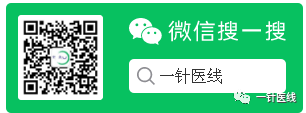

Acupuncture treatment for stiff neck
How to acupuncture for insufficient qi and blood

